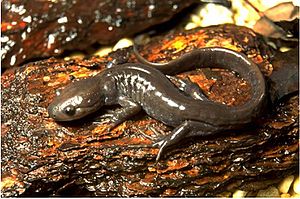Jefferson salamander facts for kids
Quick facts for kids Jefferson salamander |
|
|---|---|
 |
|
| Conservation status | |
| Scientific classification |
The Jefferson salamander (Ambystoma jeffersonianum) is a type of mole salamander. Mole salamanders spend most of their lives underground. These interesting creatures live in the northeastern United States, southern Ontario, and southwestern Quebec in Canada. This salamander got its name from Jefferson College in Pennsylvania.
Contents
What Does a Jefferson Salamander Look Like?
The Jefferson salamander is usually dark gray, brown, or black. Some can have cool silver or blue spots on their sides. These spots help them blend in with their surroundings.
They are quite skinny with a wide nose. They also have long toes that help them move around. An adult Jefferson salamander can grow to be about 11 to 18 centimeters long. That's roughly the length of a common pencil!
Where Do Jefferson Salamanders Live?
Jefferson salamanders prefer to live in deciduous forests. These are forests where trees lose their leaves in the fall. They like areas with moist soil and plenty of leaf litter. This is because they spend most of their time underground. They also need ponds or wetlands nearby for breeding.
Habits and Lifestyle
Like other mole salamanders, the Jefferson salamander is a great burrower. This means they dig tunnels and live underground. They use their strong bodies and lungs to help them dig through the soil. Living underground helps them stay safe from predators and keep cool.
These salamanders are mostly active at night. This is called being nocturnal. They come out after dark to hunt for food. During the day, they usually stay hidden in their burrows. However, they might come out during the day when it's their mating season.
Reproduction and Life Cycle
Jefferson salamanders breed in early spring. This happens right after the snow has melted in their area. They will travel to temporary ponds or flooded areas to find a mate. The female lays her eggs in small clusters attached to underwater plants or sticks.
After the eggs hatch, tiny salamander larvae emerge. These larvae live in the water and have gills to breathe. They eat small aquatic insects. As they grow, they change into their adult form. This process is called metamorphosis. Once they have changed, they leave the water and move to live on land.


